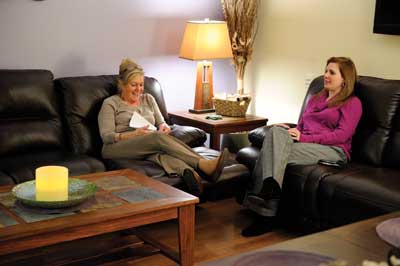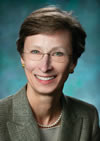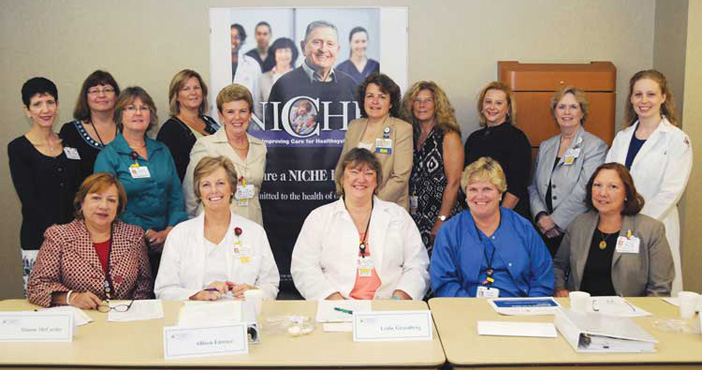From Addis Ababa to Bangladesh, regions around the world are flooding the school with requests for international collaborations and assistance. School leaders, though gratified and eager to help, are proceeding with caution, intent on finding foreign programs that make just the right fit.
By Tom Waldron
Unsolicited e-mails and letters from around the globe arrive almost daily at the office of Kathleen H. Sabatier, director of the Institute for Johns Hopkins Nursing. From Addis Ababa to Malaysia, China to Brazil, universities, colleges, nursing schools and private companies are asking for help from the School of Nursing, and they often start with Sabatier. The requests come in many varieties.

An oil company in Malaysia wants to develop a village devoted to health care for its workers and others. Can Hopkins help establish a nursing operation, the company wants to know. A doctor in China writes the school to set up a program to have Chinese nurses pass American nursing exams. Can Hopkins aid with the training?
“The opportunities come pouring in. We don’t even have to look for them,” says Sabatier, who has filled most of a file drawer with such correspondence.
For decades, Johns Hopkins professionals have carried the institution’s name abroad—from physicians working in overseas hospitals to public health professionals studying in remote villages. Although Johns Hopkins nurses have also been active in international pursuits from time to time, in recent years the number of opportunities has soared.
A widespread demand for more nurses, as well as a push in many countries to increase the professionalism of the nursing field, has prompted more and more nursing programs to reach out to their American counterparts. Given the school’s name, reputation, and history of international involvement, it is not surprising that it is being flooded with requests for collaboration and assistance.
“It’s both exciting and a burden,” Sabatier says of the possibilities of international projects. “We’re struggling to figure out how to get our arms around this. What kinds of things will we do, and what will we not do? How do we evaluate the requests?”
Perhaps no nation offers more possibilities to the school than China. Consider that in the entire country of 1.3 billion people, there are only six nurses with PhDs. Nursing higher education was re-established in China only in 1983, after a hiatus that began after World War II. Since then, dozens of nurses have earned master’s degrees in China, but no school has yet established a PhD program. The six nurses with doctorates earned their degrees outside China, some in non-nursing fields.
In June 2001, Shen Ning, the dean of the Peking Union Medical College University School of Nursing, came to Baltimore to ask the Hopkins School of Nursing to help establish a doctoral program at Peking Union. The request appealed to Dean Martha N. Hill, who traveled twice to China to meet with her counterparts in Beijing. After more than two years of discussions, the shape of such an undertaking has grown clearer. Now the two schools have completed a proposal to establish China’s first nursing doctoral program, which will be submitted for possible funding by the China Medical Board of New York, an offshoot of the Rockefeller Foundation that began supporting the Peking medical college in 1915.
The two partners also hope to secure long-term funding for the doctoral program from both Chinese and American institutions, including foundations and the federal government. With funding in place, the program’s Chinese directors would first spend time at Hopkins to become more familiar with the doctoral program’s policies, faculty, courses, and student resources.
By the summer of 2005, the first class of about a dozen Chinese students would begin taking classes in Beijing. The next year they would spend several months at Hopkins, learning how to prepare a dissertation proposal and how to defend it. In their third year, students would do research and write dissertations—with copies in both Chinese and English.
“The Hopkins nursing team played a very important role in the development of the doctoral program,” says Lu Chongmei, dean of the nursing school at Peking Union. “They helped us develop the curriculum that focuses both on the Chinese context [of nursing] and integrates standards from the United States. The Hopkins assistance will help us create the doctoral program much more quickly.”
The benefits to Peking Union are clear, but the Hopkins nursing school also stands to benefit from the joint venture, particularly its opportunities for both faculty and student exchanges.
“We need to set up some collaborative relationships between the two faculties so they can work together on research and publications around state-of-the-art nursing practices,” says Dean Hill. Plans call for a Chinese faculty member to work with one or two Hopkins faculty on a research project. These teams also would supervise Chinese doctoral students as they work on dissertation projects.
The project would allow Hopkins faculty members to “internationalize” their research and delve into health issues confronting the world’s most populous nation. Research, for example, on end-of-life decision-making in America could be compared to findings in China, giving deeper meaning to the overall study.
At the same time, the opportunity to work in China will help faculty members obtain international recognition in their field, a prerequisite for reaching full professor status.
The China project meshes nicely with a strategy the school is developing to guide its international efforts. Under that strategy, the school will focus on post-graduate programs involving peer institutions. Such programs should also provide opportunities for research and for faculty and students to study in other countries.
“These kinds of programs we know how to do,” Hill says. “We do them well, and they’re a good fit for our faculty.”
In particular, the school will focus—for now—on two countries: South Africa and China, countries that “already have infrastructure and research-intensive universities,” Hill points out.
Beyond those post-graduate pursuits, school officials know they must carefully assess other requests. For example, the school has heard from a number of financially pressed institutions in such countries as Bangladesh asking for what amounts to pro bono help. While school officials are sympathetic to the needs of such institutions, they recognize the school’s fiscal realities. “It has to be an opportunity for revenue. It can’t be something we do just for goodwill; we can’t afford it,” says Sabatier. “A lot of people think of Hopkins as a rich American institution.”
Other possible partners have money but may not have an appropriate collaboration in mind. In particular, the acute nursing shortage has led to a rash of for-profit companies springing up to train nurses in other countries; many have asked Hopkins to help set up instruction programs. The school receives two or three such offers a week but is unlikely to pursue any.
“That is one thing we’re not doing—giving classes to a couple hundred nurses to pass exams and come to the United States,” Hill says. “Our feeling is these countries need these nurses. It’s not the best use of our limited time and faculty.”
While there is a Hopkins way of providing nursing education, implementing Hopkins-style programs overseas requires flexibility. For example, the school has had to adapt to local customs as part of another major collaboration—this one with Koc University in Istanbul, Turkey.
A private university, Koc was founded a decade ago by the family of Rahmi Koc, a graduate of Johns Hopkins and one of the world’s wealthiest men. When the Koc family looked to launch a nursing school at the university several years ago, they turned to Hopkins. Two members of the faculty—associate professor Linda C. Pugh and professor Fannie Gaston-Johansson—worked in Turkey to establish a curriculum.
Last year, the first class of 21 nursing students graduated from Koc’s Hopkins-influenced program. At the same time, Koc once again chose Hopkins to evaluate its nursing program. This past October, Sabatier and Pugh returned to Istanbul to do the evaluation and make suggestions for expansion.
The Hopkins evaluators found that some elements of Hopkins nursing training worked less effectively in Turkey. For example, the intensive seven-week course in leadership that culminates the Hopkins nursing curriculum is designed to prepare nurses to be leaders in the workplace, particularly in clinical settings. In Istanbul, the course somehow took shape as a course in management in which young nursing students were assigned to work under much older nursing managers who were handling largely bureaucratic tasks.
“The students hated it,” Sabatier says.
The Turkish school also had trouble implementing the clinical practice component of courses. Too many students were assigned to work under clinical unit nurses who were too busy to provide much instruction. That often left students observing patient care rather than providing it. After its visit, the Hopkins team offered several recommendations, including some to strengthen the clinical component.
Overall, according to Pugh, the Koc nursing program is providing far more rigorous nursing training than do other Turkish schools.
The Hopkins School of Nursing has a long tradition of international collaboration.
Indeed, the current collaboration with Peking Union Medical College resumes a long-standing connection. In 1915, Anna D. Wolf, a Hopkins nursing graduate, became superintendent of nurses at PUMC and served for five years, establishing a collegiate nursing education program. She later served as dean from 1924 to 1925. (Wolf went on to serve as director of the School of Nursing and Nursing Service at Johns Hopkins from 1940 to 1955.)
Today, several members of the faculty and doctoral students are engaged in research that takes them out of the country, and students have gone to Haiti in recent years to do health screenings and immunizations—trips funded by an anonymous donor.
Likewise, a steady number of post-doctoral students from overseas have come to study at Hopkins. And many Peace Corps graduates enroll at the school to earn a degree before returning to work on nursing projects in other countries.
Earlier this year, the school hosted two mini-courses for students from Hopkins and other schools—one on nursing in international humanitarian relief efforts, and another on nursing and midwifery in international development settings (a class co-sponsored by JHPIEGO, an international non-profit group affiliated with the university working to improve health care for women and children).
On the research side, several Hopkins nursing students have taken advantage of the Global Health Promotion Research Program. Funded by the National Institutes of Health, the initiative is a component of the Minority International Research Training (MIRT) Program and aims to give minorities and others the opportunity to pursue biomedical and bio-behavioral research and training in other countries.
Now in its fifth year, the MIRT program has sent students from Hopkins (in nursing and other disciplines) to Sweden, Israel, South Africa, England, and Australia. The students work under the direction of a faculty mentor from Hopkins or one of several partner institutions. Ultimately, the program’s aim is to engage students in the overseas research experience and encourage their pursuit of graduate degrees.
Says Gaston-Johansson, director of international programs at the school and the principal investigator for the MIRT program, “It’s a tough program, but they learn a lot. When they come back, they’re different people.”
Amanda Stefancyk, 29, spent 10 weeks in Goteborg, Sweden, in the summer of 2002 and calls her participation in the MIRT program a valuable career step.
In Sweden, Stefancyk looked at ways of assessing patients’ pain levels. She and four other students helped write a 30-item survey questionnaire, interviewed patients in the hospital, and analyzed the data. The experience in Sweden helped convince Stefancyk to continue in school. She plans to enroll in a PhD program this year. “We were working with people at the top of their game in Sweden,” she says of the research she saw. “It made me want to do what they were doing and that requires a PhD and a research background.”
Hopkins is not alone among nursing schools looking to expand their horizons outside the United States.
The shortage of nurses both here and abroad is creating pressure for more and bigger nursing programs, and foreign institutions often come to America for assistance. Officials at the American Association of Colleges of Nursing in Washington, DC say they receive a steady stream of requests from foreign nursing schools seeking a partnership with an American school on such matters as faculty or curriculum development.
While some American nursing schools have neither the staff nor funding to explore such projects, others are eager to take on international projects.
The University of California, San Francisco School of Nursing collaborates with the University of Puerto Rico to oversee research studies into quality-of-life issues for patients with HIV/AIDS. And the University of Michigan School of Nursing has worked since 1996 with the Peking University School of Nursing, helping establish a nursing-led teaching clinic among other projects.
Shake Ketefian, director of the Office of International Affairs in Michigan’s nursing school, says it was important to pick only projects that would pay dividends for both Michigan and its partners overseas. “It needs to be of mutual benefit,” Ketefian says. “If we get a request that isn’t going to enhance our mission in any particular way, we will decline it.”
Although the opportunities seem boundless, nursing leaders with experience in international work are quick to advise thoughtful decision making. Rita M. Carty, former dean of George Mason University nursing school and secretary general of the Global Network of the World Health Organization Collaborating Centers for Nursing and Midwifery, applauds Hopkins for moving forward with international work but advises the school to be judicious in its ambitions. “Any work you do, you need to have the strength and expertise,” Carty says. “It’s always better to know what you can do. It’s better to do one job well than 10 jobs poorly.”
Dean Hill understands that message.
“One of our charges is to be very strategic and selective,” she says. “We can’t spread ourselves too thin, and we have to be financially as well as professionally responsible.”
Tom Waldron is a freelance writer based in Baltimore.
 A Room of Their Own Psych Nurses Find a Place to Rejuvenate
A Room of Their Own Psych Nurses Find a Place to Rejuvenate Board Certification: A Measure of Success
Board Certification: A Measure of Success Class News
Class News We're No. 4!
We're No. 4! Establishing a Continuity of Care for Older Adults
Establishing a Continuity of Care for Older Adults







